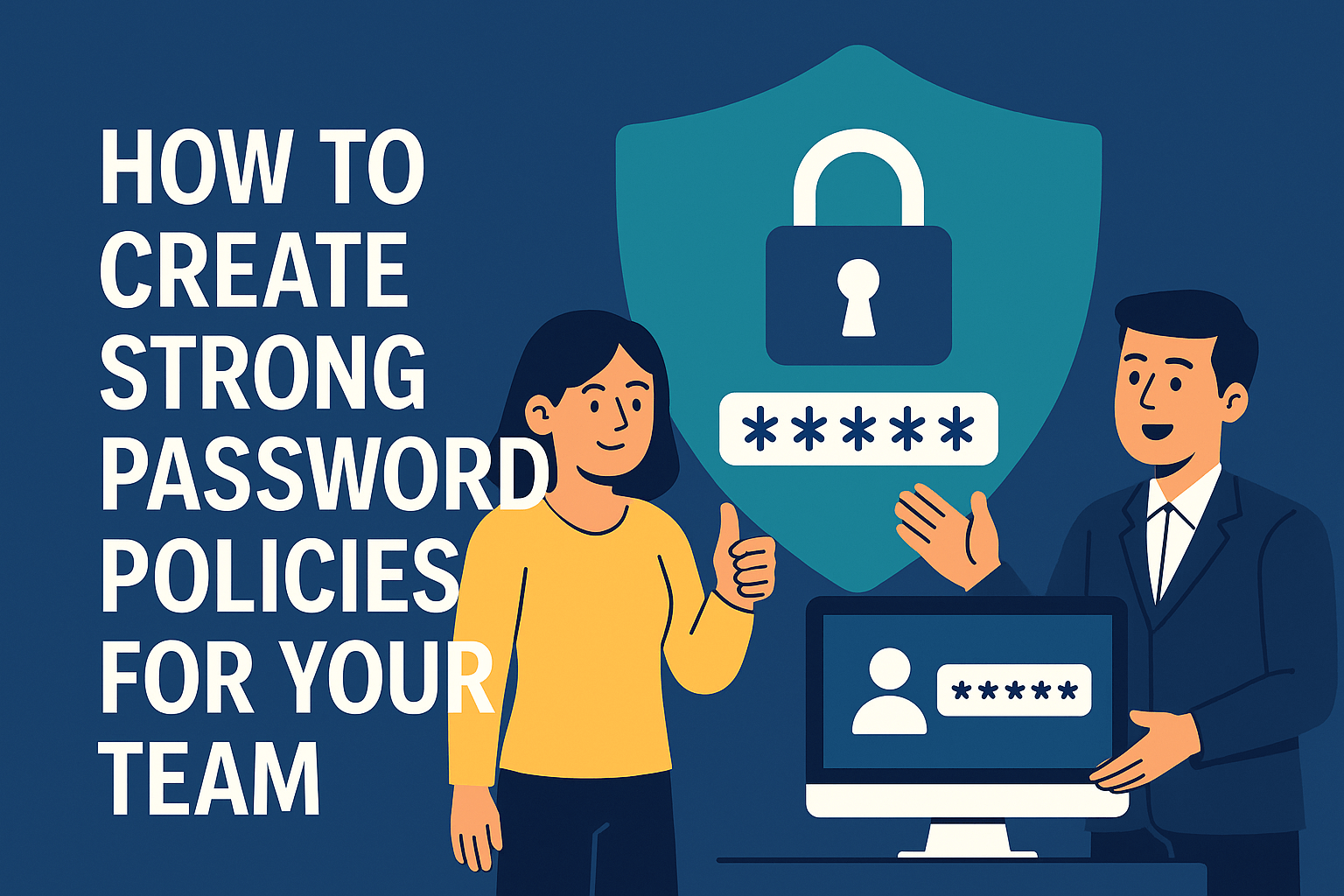
How to Create Strong Password Policies for Your Team
By InfoDefenders Editorial Team · July 28, 2025 · Cybersecurity Basics
✨ Why Password Policies Still Matter
In a world of biometrics, MFA, and zero trust, passwords remain a critical line of defense — and often the weakest link.
According to the Verizon 2024 Data Breach Investigations Report, over 60% of breaches involve stolen or weak credentials. For SMBs, where users may share devices, reuse passwords, or rely on memory, a single compromised password can expose the entire business.
But strong passwords alone aren’t enough. You need a clear, enforceable password policy that balances usability and security.
This guide shows you how to create one — step by step.
What Happens Without a Password Policy
Let’s start with the risks of doing nothing:
-
Users set short or common passwords (e.g., "Welcome123")
-
Password reuse across work and personal accounts
-
Admin accounts remain unrotated for years
-
No MFA or alerting for suspicious logins
-
No rules around shared passwords or guest access
Real-world consequences:
One compromised email account can lead to vendor fraud, internal phishing, and unauthorized system access — often silently for months.
Core Elements of a Strong Password Policy
A good password policy doesn’t just dictate length — it defines expectations, protections, and recovery procedures.
Let’s break it down.
1. 🔢 Minimum Complexity Requirements
Set a baseline for all user accounts:
✅ Minimum 12 characters (16+ for privileged users)
✅ Must include upper + lowercase, number, and symbol
✅ No dictionary words, company names, or keyboard patterns (e.g., "qwerty123")
💡 Tip: Consider passphrases like Giraffes!Love!Clouds7 — easier to remember, harder to crack.
2. 🔁 Password Rotation
For standard users:
-
No mandatory rotation unless compromise is suspected
-
Encourage long, unique passwords stored in a manager
For admins and privileged users:
-
Rotate every 90–180 days
-
Audit access logs and remove stale credentials
Note: Forced rotation every 30 days is outdated and can encourage bad habits like Password1!, Password2!, etc.
3. 🔐 Multi-Factor Authentication (MFA)
MFA is non-negotiable.
Require MFA for:
-
Admin and IT staff
-
Finance and HR portals
-
Cloud management consoles (AWS, M365, Google Workspace)
-
VPNs and remote access tools
Prefer TOTP apps (e.g., Authy, Microsoft Authenticator) or FIDO2 keys (e.g., YubiKey) over SMS.
4. 🧠 User Education
Even the best policy fails if users don't understand why it matters.
Include training on:
-
How to build strong passwords
-
Why password reuse is dangerous
-
How attackers use credential stuffing
-
How to use password managers
✅ Provide screenshots and examples in onboarding materials.
5. 📲 Password Managers
End the sticky note era.
Provide a vetted, secure password manager such as:
-
Bitwarden (open source, affordable)
-
1Password for Business
-
LastPass Teams (check breach history)
-
Keeper Security (strong SMB features)
Enforce usage policies:
-
Required for storing shared passwords
-
Disallow saving credentials in browsers
-
Auto-lock after inactivity
6. 🔒 Account Lockout & Monitoring
Protect against brute-force attacks.
Policy tips:
-
Lock accounts after 5 failed attempts (with cooldown or admin unlock)
-
Monitor login attempts by region, IP, and time
-
Alert IT on anomalies (e.g., midnight login from another country)
Tools like Microsoft 365 Security, Google Workspace Admin, or Okta can handle alerts and automated responses.
7. 🔁 Guest and Shared Account Rules
For shared environments:
-
Avoid shared logins wherever possible
-
Use individual accounts with role-based permissions
-
If shared access is required (e.g., kiosk), log usage with session recording or access auditing
🚫 Never allow email or cloud app access via shared passwords.
Sample Password Policy Template (Excerpt)
Here’s a snippet you can include in your official documentation:
Minimum Password Requirements
Must be at least 12 characters
Must include 1 uppercase, 1 lowercase, 1 number, and 1 special character
Must not include the user’s name or company name
Passphrases are encouraged (e.g.,
Time2!Drink-Coffee4)Password Rotation
Privileged accounts: rotate every 180 days
User accounts: change only if compromised
Authentication
MFA is required for all remote access and sensitive systems
SMS-based MFA is discouraged unless no alternative exists
Password Storage
Passwords must not be written down or stored in browsers
Use the company-approved password manager for all credentials
Password Policy Do’s and Don’ts
| ✅ Do This | ❌ Avoid This |
|---|---|
| Use MFA for all cloud accounts | Using SMS as your only MFA method |
| Require 12+ character passwords | Enforcing frequent rotation |
| Provide a password manager | Letting users store passwords in browsers |
| Educate with examples | Assuming users will “figure it out” |
| Audit access regularly | Keeping unused admin accounts |
Real-World SMB Example
A small marketing firm had one shared Gmail account for client coordination. It used the password Marketing2022!.
This password was reused on a compromised site. An attacker accessed the inbox, spoofed invoices to clients, and rerouted payments — costing the firm $17,000.
After the incident, they adopted:
-
Unique accounts
-
Bitwarden for shared logins
-
MFA across all Google Workspace users
-
Alerts for login attempts from outside the U.S.
Compliance Considerations
If your business is subject to:
-
HIPAA: Requires “unique user identification” and secure login procedures
-
SOC 2: Password complexity and access control audits are common
-
ISO 27001: Controls for authentication, password storage, and policy management
Make sure your password policy aligns with the NIST SP 800-63B guidelines.
Final Thoughts: Making Password Policies Work
A password policy isn’t a document — it’s a culture. When you:
-
Provide tools (password manager)
-
Enforce smart defaults (MFA, complexity)
-
Train your people
-
Monitor your systems
...you create a team that understands security is everyone’s job.
🔐 Passwords may be simple — but their impact is profound.
📥 Download: Free Password Policy Template for SMBs
Get started today with our editable Password Policy Template (PDF + DOCX) — crafted for SMBs, MSPs, and IT teams.
👉 Download the Template →